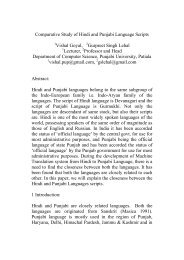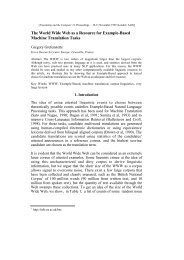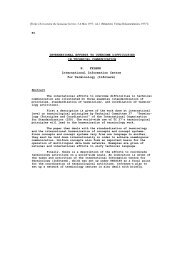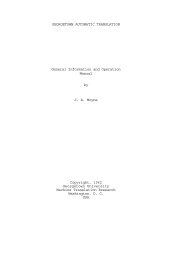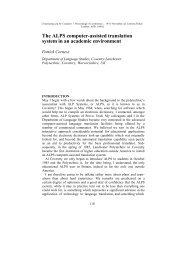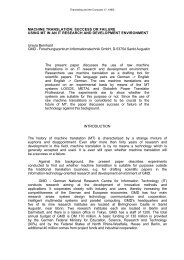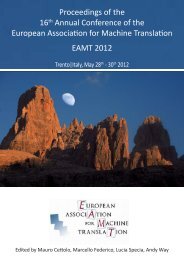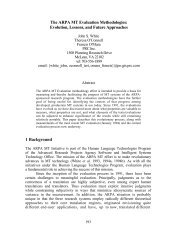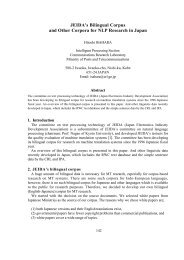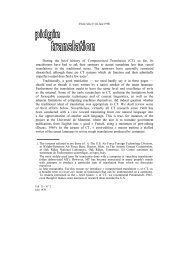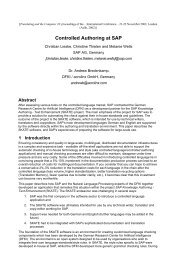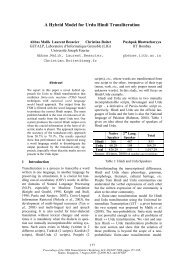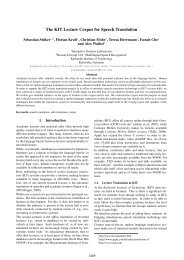Machine translation with inferred finite-state transducers
Machine translation with inferred finite-state transducers
Machine translation with inferred finite-state transducers
Create successful ePaper yourself
Turn your PDF publications into a flip-book with our unique Google optimized e-Paper software.
Computational Linguistics Volume 30, Number 2<br />
García, and Vidal 1993; Mäkinen 1999; Knight and Al-Onaizan 1998; Bangalore and<br />
Ricardi 2000b; Casacuberta 2000; Vilar 2000). Nevertheless, there are many techniques<br />
for inferring regular grammars from <strong>finite</strong> sets of learning strings which have been<br />
used successfully in a number of fields, including automatic speech recognition (Vidal,<br />
Casacuberta, and García 1995). Some of these techniques are based on results from<br />
formal language theory. In particular, complex regular grammars can be built by inferring<br />
simple grammars that recognize local languages (García, Vidal, and Casacuberta<br />
1987).<br />
Here we explore this idea further and propose methods that use (simple) <strong>finite</strong><strong>state</strong><br />
grammar learning techniques, such as n-gram modeling, to infer rational <strong>transducers</strong><br />
which prove adequate for language <strong>translation</strong>.<br />
The organization of the article is as follows. Sections 2 and 3 give the basic definitions<br />
of a <strong>finite</strong>-<strong>state</strong> transducer and the corresponding stochastic extension, presented<br />
<strong>with</strong>in the statistical framework of language <strong>translation</strong>. In Section 4, the proposed<br />
method for inferring stochastic <strong>finite</strong>-<strong>state</strong> <strong>transducers</strong> is presented. The experiments<br />
are described in Section 5. Finally, Section 6 is devoted to general discussion and<br />
conclusions.<br />
2. Finite-State Transducers<br />
A <strong>finite</strong>-<strong>state</strong> transducer, T , is a tuple 〈Σ, ∆, Q, q0, F, δ〉, in which Σ is a <strong>finite</strong> set of<br />
source symbols, ∆ is a <strong>finite</strong> set of target symbols (Σ ∩ ∆=∅), Q is a <strong>finite</strong> set of<br />
<strong>state</strong>s, q0 is the initial <strong>state</strong>, F ⊆ Q is a set of final <strong>state</strong>s, and δ ⊆ Q × Σ × ∆ ⋆ × Q is<br />
a set of transitions. 1 A <strong>translation</strong> form φ of length I in T is defined as a sequence of<br />
transitions:<br />
206<br />
φ =(q φ<br />
0 ,sφ 1<br />
φ<br />
,¯t , qφ<br />
1<br />
1 )(qφ 1 ,sφ 2<br />
φ<br />
,¯t , qφ<br />
2<br />
2 )(qφ 2 ,sφ 3<br />
φ<br />
,¯t 3 , qφ<br />
3 ) ...(qφ I−1 ,sφ<br />
φ<br />
I ,¯t I , qφ<br />
I ) (1)<br />
where (q φ<br />
i−1 ,sφ<br />
φ<br />
i ,¯t i , qφ<br />
i ) ∈ δ, qφ<br />
0 = q0, and q φ<br />
I ∈ F. A pair (s, t) ∈ Σ⋆ × ∆⋆ is a <strong>translation</strong><br />
pair if there is a <strong>translation</strong> form φ of length I in T such that I =|s| and t = ¯t φ¯t<br />
φ φ<br />
1 2 ...¯t I .<br />
By d(s, t) we will denote the set of <strong>translation</strong> forms2 in T associated <strong>with</strong> the pair (s, t).<br />
A rational <strong>translation</strong> is the set of all <strong>translation</strong> pairs of some <strong>finite</strong>-<strong>state</strong> transducer T .<br />
This definition of a <strong>finite</strong>-<strong>state</strong> transducer is similar to the definition of a regular<br />
or <strong>finite</strong>-<strong>state</strong> grammar G. The main difference is that in a <strong>finite</strong>-<strong>state</strong> grammar, the set<br />
of target symbols ∆ does not exist, and the transitions are defined on Q × Σ × Q. A<br />
<strong>translation</strong> form is the transducer counterpart of a derivation in a <strong>finite</strong>-<strong>state</strong> grammar,<br />
and the concept of rational <strong>translation</strong> is reminiscent of the concept of (regular)<br />
language, defined as the set of strings associated <strong>with</strong> the derivations in the grammar<br />
G.<br />
Rational <strong>translation</strong>s exhibit many properties similar to those shown for regular<br />
languages (Berstel 1979). One of these properties can be <strong>state</strong>d as follows (Berstel 1979):<br />
Theorem 1<br />
T ⊆ Σ ⋆ × ∆ ⋆ is a rational <strong>translation</strong> if and only if there exist an alphabet Γ, a regular language<br />
L ⊂ Γ ⋆ , and two morphisms hΣ : Γ ⋆ → Σ ⋆ and h∆ : Γ ⋆ → ∆ ⋆ , such that T = {(hΣ(w), h∆(w)) |<br />
w ∈ L}.<br />
1By∆ ∗ and Σ ∗ , we denote the set of <strong>finite</strong>-length strings on ∆ and Σ, respectively.<br />
2 To simplify the notation, we will remove the superscript φ from the components of a <strong>translation</strong> form<br />
if no confusion is induced.



